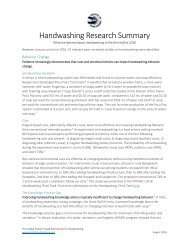WASH’ Nutrition
manuel_wash_nutrition_online
manuel_wash_nutrition_online
You also want an ePaper? Increase the reach of your titles
YUMPU automatically turns print PDFs into web optimized ePapers that Google loves.
1 Health workforce/human resources: Train and build capacity among health staff at the district, sub-district, and<br />
regional levels in delivering integrated WASH and nutrition messages and services, especially in difficult circumstances,<br />
such as humanitarian emergencies; advocate for the basic WASH and nutrition curriculums at all health system levels;<br />
organize regular information exchange sessions for WASH and nutrition staff, especially during the seasonal peaks of<br />
diarrhea, malaria and severe acute malnutrition.<br />
2 Service delivery: Put more emphasis on improving quality of water used for appetite tests in nutrition centres; strengthen<br />
public health programmes and infrastructure for water and sanitation systems and regulate water providers to meet<br />
quality and equity standards; integrate promotion of child care practices, including proper hygiene, breastfeeding,<br />
complementary feeding, and deworming practices into the primary, secondary, and tertiary healthcare systems.<br />
3 Health system financing: Emphasize the importance of WASH in nutrition advocacy campaigns; improve INGO/<br />
consortium coordination for fundraising and financial support.<br />
4 Medical products, vaccines and technologies: Strengthen supply chains to ensure access to supplements and nutritional<br />
products to treat and prevent micronutrient deficiencies and severe acute malnutrition. Harmonize distributions of<br />
water filters/purification systems to vulnerable households with distribution of folic acid/iron supplements to children<br />
and pregnant woman.<br />
5 Leadership and governance: Advocate for WASH and nutrition strategy at the national level; work on improving<br />
coordination mechanisms between WASH and nutrition sectors and clusters (where applicable); establish a joint WASH<br />
and nutrition working group at the national/regional/local level.<br />
6 Health information system (HIS): Improve accuracy, validity and standardization of WASH and nutrition data; support<br />
government in data analysis and utilization.<br />
Key messages on integrating WASH and <strong>Nutrition</strong> at the national level<br />
KEY<br />
MESSAGES<br />
Addressing the multi-dimensional, underlying causes of undernutrition requires building coalitions<br />
and partnerships as well as establishing coordination mechanisms at the national level. A multisectoral<br />
national approach is the key for sustained improvements in the nutritional status of the<br />
population.<br />
Different countries are at different stages when it comes to WASH and nutrition policy and<br />
strategy integration. Depending on the opportunities and challenges of each context, different<br />
approaches are to be used to develop or strengthen the national policy environment for WASH<br />
and nutrition integration.<br />
Public health and nutrition are interdependent. By integrating public health and nutrition<br />
efforts, existing resources can be leveraged to maximize impact. This requires integrating nutrition<br />
outcomes within the design, monitoring, and reporting system used by the Ministry of Health.<br />
Health systems play a key role in terms of WASH and nutrition integration. There are various<br />
opportunities for strengthening health system building blocks through alignment and integration<br />
of WASH and nutrition interventions.<br />
106<br />
<strong>WASH’</strong><strong>Nutrition</strong><br />
A practical guidebook



